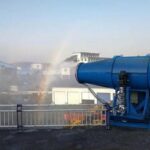Mist cannon machine is a specialized dust suppression system that disperses fine water droplets into the air to trap and settle dust particles. The machine consists of a high-powered fan, a water pump, a nozzle system, and a rotating mechanism that ensures widespread coverage. These machines are widely used in construction sites, mining operations, cement factories, and other industrial applications where dust control is crucial. The mist created by the machine binds with airborne dust particles, making them heavier and causing them to fall to the ground, thus significantly reducing air pollution and health risks.
Mist Cannon Machine Technology
At its core, a fog cannon machine is a sophisticated device designed to generate a fine, high-velocity mist that can travel significant distances. This mist effectively captures and suppresses airborne particles, including dust, pollutants, and odors. The technology relies on a combination of high-pressure pumps, specialized nozzles, and powerful fans to create and propel the mist. The process begins with water being pumped at high pressure through a series of nozzles. These nozzles atomize the water into extremely fine droplets, creating a mist that resembles a dense fog. The powerful fan then propels this mist into the air, covering a large area. The size and density of the water droplets are crucial factors in the machine’s effectiveness. Smaller droplets have a larger surface area relative to their volume, allowing them to more efficiently capture and bind with airborne particles.
Benefits of Fog Cannon Machines
The adoption of mist cannon offers numerous benefits:
Effective Dust Suppression: Mist cannon machines are highly effective at capturing and suppressing airborne dust particles, significantly improving air quality.
Environmental Protection: By reducing dust and pollutant emissions, fog cannons contribute to environmental protection and sustainability.
Improved Worker Health and Safety: Dust suppression is crucial for protecting worker health and safety in industries such as construction, mining, and waste management.


